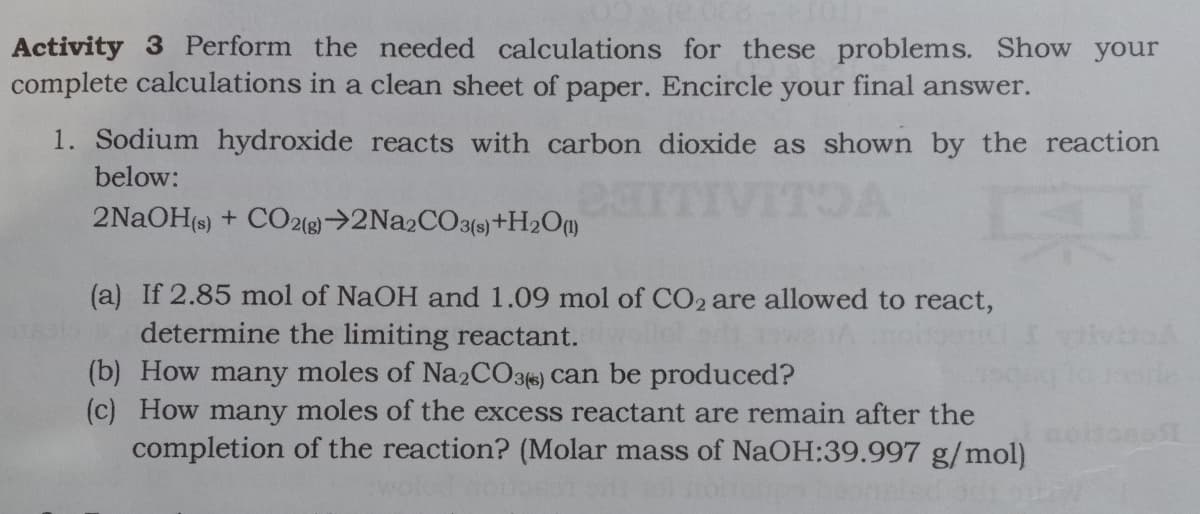Activity 3 Perform the needed calculations for these problems. Show your complete calculations in a clean sheet of paper. Encircle your final answer. 1. Sodium hydroxide reacts with carbon dioxide as shown by the reaction below: TOA 2NaOH(s) + CO2()→2N22CO3()+H2Om (a) If 2.85 mol of NaOH and 1.09 mol of CO2 are allowed to react, determine the limiting reactant. (b) How many moles of Na2CO3%) can be produced? (c) How many moles of the excess reactant are remain after the completion of the reaction? (Molar mass of NaOH:39.997 g/mol)
Activity 3 Perform the needed calculations for these problems. Show your complete calculations in a clean sheet of paper. Encircle your final answer. 1. Sodium hydroxide reacts with carbon dioxide as shown by the reaction below: TOA 2NaOH(s) + CO2()→2N22CO3()+H2Om (a) If 2.85 mol of NaOH and 1.09 mol of CO2 are allowed to react, determine the limiting reactant. (b) How many moles of Na2CO3%) can be produced? (c) How many moles of the excess reactant are remain after the completion of the reaction? (Molar mass of NaOH:39.997 g/mol)
Chemistry for Engineering Students
4th Edition
ISBN:9781337398909
Author:Lawrence S. Brown, Tom Holme
Publisher:Lawrence S. Brown, Tom Holme
Chapter4: Stoichiometry
Section: Chapter Questions
Problem 4.96PAE
Related questions
Question

Transcribed Image Text:Activity 3 Perform the needed calculations for these problems. Show your
complete calculations in a clean sheet of paper. Encircle your final answer.
1. Sodium hydroxide reacts with carbon dioxide as shown by the reaction
below:
TOA
2NaOH(s) + CO2()→2N22CO3()+H2Om
(a) If 2.85 mol of NaOH and 1.09 mol of CO2 are allowed to react,
determine the limiting reactant.
(b) How many moles of Na2CO3) can be produced?
(c) How many moles of the excess reactant are remain after the
completion of the reaction? (Molar mass of NaOH:39.997 g/mol)
Expert Solution
This question has been solved!
Explore an expertly crafted, step-by-step solution for a thorough understanding of key concepts.
Step by step
Solved in 5 steps with 4 images

Knowledge Booster
Learn more about
Need a deep-dive on the concept behind this application? Look no further. Learn more about this topic, chemistry and related others by exploring similar questions and additional content below.Recommended textbooks for you

Chemistry for Engineering Students
Chemistry
ISBN:
9781337398909
Author:
Lawrence S. Brown, Tom Holme
Publisher:
Cengage Learning

Introductory Chemistry: A Foundation
Chemistry
ISBN:
9781337399425
Author:
Steven S. Zumdahl, Donald J. DeCoste
Publisher:
Cengage Learning

Chemistry for Engineering Students
Chemistry
ISBN:
9781337398909
Author:
Lawrence S. Brown, Tom Holme
Publisher:
Cengage Learning

Introductory Chemistry: A Foundation
Chemistry
ISBN:
9781337399425
Author:
Steven S. Zumdahl, Donald J. DeCoste
Publisher:
Cengage Learning